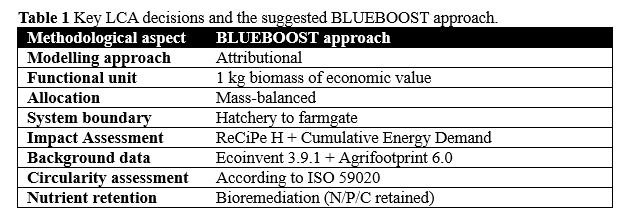FIT-FOR-PURPOSE ENVIRONMENTAL AND ECONOMIC SUSTAINABILITY ASSESSMENT OF INTEGRATED MULTI-TROPHIC AQUACULTURE
Introduction
Integrated multitrophic aquaculture (IMTA), i.e. co-farming of species from different trophic levels, combines aquatic species into one farming system to provide benefits for: i) one or several of the farmed species , e.g. seaweed can grow faster in the nutrient rich waters from fish farming, and/or ii) ecosystems , i.e. nutrient up take from fish farming, a nd iii) aquaculture producers, e.g. better productivity and new revenue streams – combined allowing for production efficiencies as more biomass is produced from the system . T his is aligned with societal ambition s on resource-efficien cy, circular ity and mitigation of drivers for biodiversity loss . Despite the potential benefits, IMTA remains uncommon in Europe, where its application has been mainly limited to pilot-scale trials within the framework of research project s.
In t he BLUEBOOST project (https://www.blueboost.eu/) , suitable design of IMTA systems will be investigated. Case stud y experiments are undertaken in Italy, Spain, Portugal, Poland and Brazil and evaluated as to their environmental and economic sustainability . One area of focus is the s pecific methodological choices needed to assess environmental impacts and benefits of the multi- and circular output nature of IMTA systems. Although some insights have been gained using Life Cycle Assessment (LCA) – feed, effluents and energy use are impact hotspots – a standardized LCA methodology of IMTAs is called for (Hala et al 2024) . Further, reduced externalities have so far been underexplored in cost-benefit analysis (CBA) of aquaculture (Knowler et al. 2020).
Method
An initial LCA literature screening in March 2024, resulted in four studies applying LCA on IMTA (Chary et al. 2020; Mendoza Beltran et al. 2018; Prescott 2017; Wilfart et al. 2020) , from which k ey methodological decisions were extracted , compared and discussed to derive a suitable approach for harmonized evaluation of IMTA systems for BLUEBOOST (Ziegler et al. 2024). Further, w e explored the general CBA literature, economic assessments of IMTA and literature on the valuation of environmental externalities relevant in the aquaculture context. I nsights gained are important to share and discuss with IMTA experts and LCA practitioners beyond the project for good practice sustainability assessments of IMTAs beyond BLUEBOOST . We have therefore undertaken a more structured systematic literature review in Scopus , identifying additional documents of interest. These are currently in the process of being analyzed to see if and how they add to the findings from the screening and inform on a more comprehensive overview to provide overall good practices when applying LCA to IMTA.
Here we present the results from the initial screening and the methodology suggested for sustainability assessment in BlueBoost, which is work in progress as additional publications will be analyzed and discussed during spring 2025 for a more generic decision-support framework .
Results
The four IMTA LCA studies all focus on different systems and, most importantly, use different LCA method decisions . Functional units varied considerably, i.e. the output of the system which environmental pressures are related to – and which has a strong effect on results. Further, how to allocate environmental burdens between main product and co-products and choice of impact assessment method (and environmental impact categories included) also matter for results on IMTA system performance. Comparability of results between studies is therefore limited without harmonization . The key method choices suggested for BLUEBOOST are found in Table 1.
Drawing on general CBA practices and extant economic assessments of IMTA systems (e.g. da Silva et al. 2022), an applied cash flow calculator is being formulated. In case studies with important environmental externalities, we attempt to identify feasible monetary valuations to be used in the social CBA.
Discussion
Robust and comparative LCAs are vital to understand differences between aquaculture production systems and how they can be optimized. A decision-support tool will assist LCA practitioners in future assessments. Alongside , a suitable economic assessment is required to ensure that the proposed solutions are economically viable.
References
Chary et al. (2020) Integrated multi-trophic aquaculture of red drum (Sciaenops ocellatus)
and sea cucumber (Holothuria scabra ): Assessing bioremediation and life-cycle impacts. Aquaculture 516: 734621.
da Silva et al. (2022) Economic feasibility of integrated multi-trophic aquaculture (mussel
Perna perna , scallop Nodipecten nodosus and seaweed Kappaphycus alvarezii ) in Southeast Brazil: A small-scale aquaculture farm model. Aquaculture , 552, 738031
Hala et al. (2024) Life Cycle Assessment of integrated multi-trophic aquaculture: A review
on methodology and challenges for its sustainability evaluation. Aquaculture 590(2024)741035
Knowler et al. (2020) The economics of Integrated Multi-Trophic Aquaculture: where are we now and where do we need to go?. Rev . Aquac . 12, 1579-1594.
Mendoza Beltran et al. (2018). Accounting for inventory data and methodological choice
uncertainty in a comparative life cycle assessment: the case of integrated multi-trophic aquaculture in an offshore Mediterranean enterprise. Int J LCA 23, 1063-1077.
Prescott (2017). Exploring the Sustainability of Open-Water Marine, Integrated Multi-
Trophic Aquaculture, Using Life-Cycle Assessment. Thesis, University of Stirling. http://hdl.handle.net/1893/28269
Wilfart et al. (2020) . Integrated multi-trophic aquaculture in ponds: What environmental
gain? An LCA point of view. 12th International Conference on Life Cycle Assessment of Food 2020, Oct 2020, Berlin, Germany. pp.206-208.
Ziegler et al. (202 4) BlueBoost Deliverable 12 Internal report.

